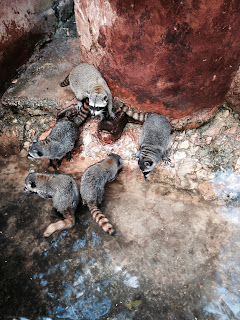 |
| Playa del Carmen: Surfer's Paradise of Mexico |
Yikes. The bus station is really overwrought. It's not a large station, and there are young American backpackers and older tourists all spilling out onto the road. We scoff some empanadas and try to navigate our way to some tickets and the correct bus. There are too many buses for the station, about 4 in enough space for only 3. Tulum seems to be breaking under the weight of the influx of tourists.
It's only an hour north to our next stop, Playa del Carmen. We're now in the thick of the Maya Riviera; it's a bigger city, very commercial, endless stretches of restaurants along pedestrian-only streets. It's a very far cry from all of our previous Mexican stops. I would liken it to Surfer's Paradise, only with a lot more white people. The other real differences are that Playa del Carmen has spectacular bleached Caribbean beaches, and the locals aren't really restricted by the same laws as we are back in Australia. You can put your feet in a tank full of carnivorous little fish that eat all of your dead skin off (we did this), hold a baby Capuchin monkey or pat a lion cub (yeah, we did that too, although I didn't really want to), or just lay on the public beach while waiters bring you drinks (guilty as charged). Everywhere throughout the city there are American, Canadian, European and British tourists in swimming costumes. I don't really notice any other Australians today. At one point we see a group of American women in matching pink T-shirts proclaiming that they are on a Mexican hen's party. Some of them are 60 years old, some are clearly about 15, and one has a pram with a baby in it. What kind of hen's party is that?! Why would you go all the way to a Mexican party zone with seniors and babies? Like, why go all the way to Mexico to have a crap time when you can just have a crap time at home?
The shop assistants are full-on here. They all have different tactics to try and get you into their shops. Some are overly friendly and ask questions like, "Where you from?", others are smart-alecs, "You been everywhere, even Disneyland?" Some try to lock you up in their shop and subtly block your exit (this happened twice to us, with the proprietor shunting us into a hidden back room and then trying to close us in there!).
I think I'm glad we only have a few days left now. I feel like we've left the real Mexico behind us... the Maya Riviera takes U.S. dollars everywhere, is full of fellow tourists, and the Mexicans all speak English. What's the point of coming to another country if all you're going to do is hang out in a commercial district modeled on the worst excesses of America? It doesn't make sense to me.
 |
| Either an albatross or a frigate bird. If you know, let me know! |
 |
| Lobster... oh yeah! |
 |
| Ceviche is an uncooked seafood dish where citric acid is used to prepare the food. It's common across Central and South America. We can say we tried it now. Never again. |










































































